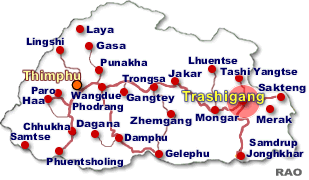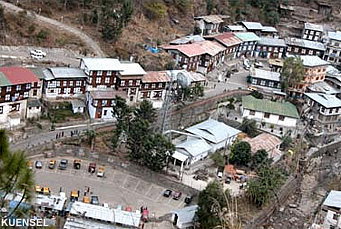 |
Bhutan Development |
 |
Bhutan Information |
|
|
 |
 |
|
Trashigang
town: old and vulnerable
|

|
 |
| Trashigang
town, one of the oldest urban centres in eastern part of the country, is
not new to natural disasters.
The
Mithridrang stream that flows through the town has flooded on several occasions
in the past and caused large-scale destruction of property.
Huge
boulders perched on the bare cliffs overlooking the town threaten to roll
down anytime and there have been incidents where a loose boulder has crashed
into the cluster of houses below. |
|
But
the recent fire incident in which the living quarters and belongings of
15 families were burnt to the ground has residents talking of how vulnerable
the town is to flames. Trashigang town is mostly made up of traditional
wooden structures that are crammed together in the little available space.
"Until
now we had other disasters to worry about," said 27-year old Dorji, who
grew up in the town. "But with houses getting older fire is a real threat.
It could eat up the entire town in one go."
Though
the cause of the fire is still not known, Trashigang dzongda Minjur Dorji
said that old fragile wires in the house may have caused the fire. "Besides
being one of the oldest towns, Trashigang was also one of the first few
towns to be electrified in the early seventies," he said. "And since then,
most of the house owners have not changed the electric wiring."
The
last fire incident in the town happened in 2002 when a house near the bus
station was burnt down by a blasting gas cylinder.
 |
Trashigang Town
| Since
2006 the dzongkhag had encouraged private builders to construct concrete
buildings. "We have no other options," said the dzongda. "Besides, the
builders have realised that building concrete structures are much cheaper
and convenient whereas timber is difficult to obtain and is more expensive."
According
to the dzongkhag municipal office the 138-acre town, excluding the extensions,
consists of 119 permanent buildings including government buildings, 32
semi permanent houses and 35 hutments. |
|
"Of
these structures, more than 90 percent are old traditional houses," said
the municipal engineer.
In
the core town area there are five one-storey traditional buildings, 25
two-storey and 20 three-storey traditional buildings. The town has only
six concrete private and the government buildings.
The
engineer said that the houses which were very close to each other, were
also built from materials that could easily catch fire. "The municipal
office has constantly reminded house owners to change wiring but not one
has done so," she said, adding that electric wires were also supplied to
some of the houses.
According
to the Bhutan Building rules every house should have fire extinguishers,
but it was noticed that only a few had them despite it being made mandatory
by the municipality. And among those who had it most did not know how to
use it.
The
town has proposals to increase the number of fire hydrants in the town
area. "We have three fire hydrants in the dzong area, upper and the lower
market, we need to have few more in the residential areas," said the engineer.
In the dzong area buckets filled with water are kept ready 24 hours.
However,
dzongda Minjur Dorji said that the dzongkhag had only one fire-fighting
engine, which was not sufficient considering the size of the town and its
population.
A
spokesperson for the Royal Bhutan Police said that police personnel were
taught fire fighting drills to supplement the fire department but lacked
professional training or equipment.
The
much talked about plan to shift the entire town to a new location appears
to have fallen through. Dzongda Minjur Dorji said that it would be impossible
to relocate the town. "We have the dzongkhag administration, the rabdey,
school, hospital and the necessary infrastructure here," he said.
Chief
town planner Megraj Adhikari said that there were no such plans and the
town would remain in the present location. But the town would be extended
upward towards a village called Melphay. "Considering the physical constrains
of the present town selective construction would be allowed which does
not promote a high density town," he said.
The
extension and completion of living quarters under the urban housing plan
is expected to ease the housing crunch and major facelift work is also
being carried out with support from DANIDA and the government to improve
water supply, lighting, sewerage, riverbank retention walls and drainage
systems. The dzongkhag is also prioritising the need for parking space
and proper garbage disposal.
With
the watershed management and flood prevention works underway dzongkhag
officials said the problem of flashfloods and shooting boulders should
stabilise. Additional preventive works would be carried out by constructing
chain links.
Megraj
Adhikari said that the beauty of Trashigang town was the traditional architecture
of the houses and any attempt to change it would spoil its beauty. "While
fire within a house can be prevented by using proper quality materials,
it is up to people to prevent fire from external sources," he said. "It
is also a general observation that traditional houses withstood earthquakes
better than concrete buildings."
Only
about 10 houses in the entire town were insured against fire hazards and
these were houses that had loans with financial institutions.
Given
the situation, fires could be the biggest threat to the oldest town in
eastern Bhutan.
| Contributed
by Kesang Dema, Kuensel, Bhutan's National Newspaper 2007 |
 |
| more information on Bhutan |
 |
|





